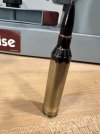aachey
Active Member
Reloading for a buddys 264 win mag. Full disclosure it has an aftermarket barrel on a 700 action and stock. All i have for brass is what id assume to be shot through it already, and no factory new brass. My rcbs fl resizing die is as low as it goes but with the sharpie trick i get marks on the shoulder and a tighter than preferred bolt closing. A couple cases are 1-2 thou shorter(hornady measuring tools) and the bolt closes with ease. But the majority close with some resist on the bolt. More than id like to feel. The die cant go any lower tho. Also all the cases measure 2.488. I dont want to assume it has a tight headspace(i dont have a guage) but given the aftermarket barrel id obviously lean that way. Also the solid ring at the top of the should is from the measuring tool.


